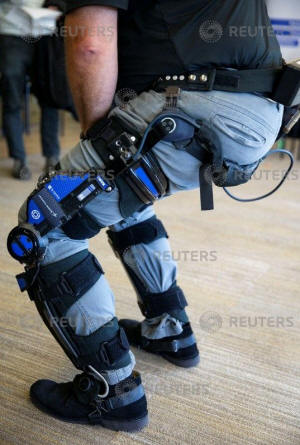|
Pentagon looks to exoskeletons to build
'super-soldiers'
 Send a link to a friend
Send a link to a friend
 [November 30, 2018]
By Phil Stewart [November 30, 2018]
By Phil Stewart
WASHINGTON (Reuters) - The U.S. Army is
investing millions of dollars in experimental exoskeleton technology to
make soldiers stronger and more resilient, in what experts say is part
of a broader push into advanced gear to equip a new generation of
"super-soldiers."
The technology is being developed by Lockheed Martin Corp <LMT.N> with a
license from Canada-based B-TEMIA, which first developed the
exoskeletons to help people with mobility difficulties stemming from
medical ailments like multiple sclerosis and severe osteoarthritis.
Worn over a pair of pants, the battery-operated exoskeleton uses a suite
of sensors, artificial intelligence and other technology to aid natural
movements.
For the U.S. military, the appeal of such technology is clear: Soldiers
now deploy into war zones bogged down by heavy but critical gear like
body armor, night-vision goggles and advanced radios. Altogether, that
can weigh anywhere from 90 to 140 pounds (40-64 kg), when the
recommended limit is just 50 pounds (23 kg).
"That means when people do show up to the fight, they're fatigued," said
Paul Scharre at the Center for a New American Security (CNAS), who
helped lead a series of studies on exoskeletons and other advanced gear.
"The fundamental challenge we're facing with infantry troops is they're
carrying too much weight."
Lockheed Martin said on Thursday it won a $6.9 million award from the
U.S. Army Natick Soldier Research, Development and Engineering Center to
research and develop the exoskeleton, called ONYX, under a two-year,
sole-source agreement.

Keith Maxwell, the exoskeleton technologies manager at Lockheed Martin
Missiles and Fire Control, said people in his company's trials who wore
the exoskeletons showed far more endurance.
"You get to the fight fresh. You're not worn out," Maxwell said.
Maxwell, who demonstrated a prototype, said each exoskelelton was
expected to cost in the tens of thousands of dollars.
B-TEMIA's medically focused system, called Keeogo, is sold in Canada for
about C$39,000 ($30,000), company spokeswoman Pamela Borges said.
The United States is not the only country looking at exoskeleton
technology.
[to top of second column]
|

Keith Maxwell, Senior Product Manager of Exoskeleton Technologies at
Lockheed Martin, demonstrates an Exoskeleton during a Exoskeleton
demonstration and discussion, in Washington, U.S., November 29,
2018. REUTERS/Al Drago

Samuel Bendett at the Center for Naval Analyses, a federally funded
U.S. research and development center, said Russia and China were
also investing in exoskeleton technologies, "in parallel" to the
U.S. advances.
Russia, in particular, was working on several versions of
exoskeletons, including one that it tested recently in Syria,
Bendett said.
The CNAS analysis of the exoskeleton was part of a larger look by
the Washington-based think tank at next-generation technologies that
can aid soldiers, from better helmets to shield them from blast
injuries to the introduction of robotic "teammates" to help resupply
them in war zones.
The CNAS studies can be seen here: https://www.cnas.org/super-soldiers
(This story has been refiled to remove acronym in paragraph 13)
($1 = 1.3279 Canadian dollars)
(Reporting by Phil Stewart; Editing by Peter Cooney)
[© 2018 Thomson Reuters. All rights
reserved.]
Copyright 2018 Reuters. All rights reserved. This material may not be published,
broadcast, rewritten or redistributed.
Thompson Reuters is solely responsible for this content.
 |